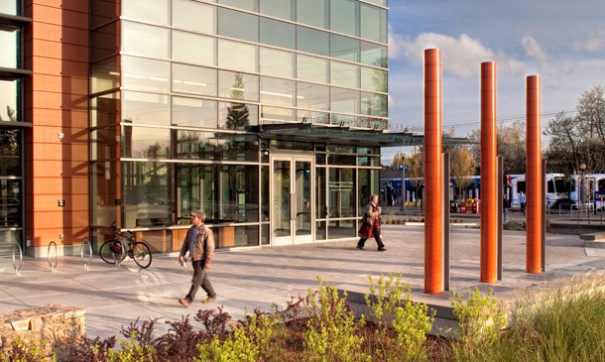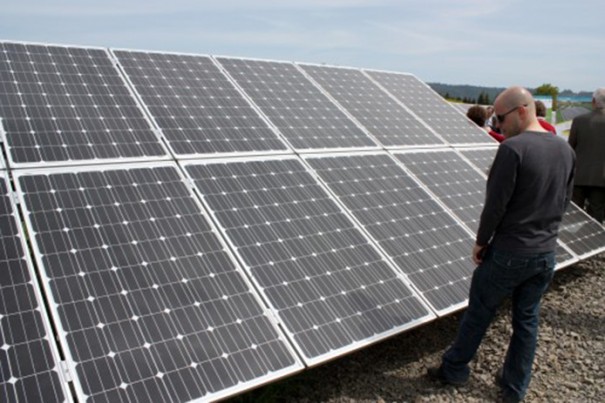This content was published: February 17, 2011. Phone numbers, email addresses, and other information may have changed.
PCC surpasses goals for energy conservation and efficiency
Photos and story by Christine Egan
At campuses and centers throughout the Portland Community College district, the PCC Bond Program is giving the green light to ambitious projects that support the college’s sustainability goals – and then some.

The red buoys at Willow Creek serve double duty as public art and filtering stormwater from the building’s 33,000-square-feet roof. Photo by Josh Partee Photography.
When voters passed the PCC bond measure in 2008, the sustainability commitment for new buildings was to meet LEED Silver standards. A little more than two years, a LEED Platinum-rated building, and a planned net zero building later, it’s clear the PCC Bond Program is exceeding that commitment.
“I think there’s a desire to be a leader,” said PCC’s Sustainability Manager Alexander de Roode. “Especially as a public institution, we have a responsibility to taxpayers and our students, who pay tuition, to go through the due diligence of being environmentally responsible, socially responsible, economically responsible – that’s the triple bottom line of sustainability.”
PCC Managing Architect Grant Bennett for the PCC Bond Program agrees that students and district residents are sending a clear message that conscientious use of resources is high on the list of priorities.
“The desire of our student population and those we serve to see the college as a living, breathing example of sustainable principles is everywhere,” said Bennett. “I call it the groundswell, and the literal embodiment of the groundswell is the President’s Climate Commitment.”
In 2007, PCC District President Preston Pulliams signed the American and University Presidents’ Climate Commitment, which required the college to create a plan to become carbon neutral. PCC’s Climate Action Plan, which was developed carefully over the course of two years, pledges to reduce greenhouse gas emissions 10% below 2006 levels by 2012, 40% below 2006 levels by 2030 and 80% below 2006 levels by 2050.
When architecture, engineering firms and design firms sign on to do bond program projects, they must take this commitment into consideration. “Many of them, if not all refer to our Climate Action Plan to see how they can align their design to help us meet these goals,” said de Roode.
The results, so far, have been impressive to say the least. Some accomplishments of the Bond Program include:
A new center on the “Path to Net Zero”
Bond Project Manager Gary Sutton names Newberg Center as his favorite “green” project. “It is a 13,000-square-foot building on pace for LEED Platinum and is also a Path to Net Zero building,” said Sutton. As one of fifteen participants in the Energy Trust of Oregon’s Path to Net Zero pilot program, Newberg Center has a goal of achieving net-zero on-site building energy use. The building has already won an award for sustainable design.
A comprehensive, district-wide solar assessment
Recently, the BacGen Solar Group and Oh planning+design, a woman-owned architectural firm, won the contract to conduct a district-wide solar feasibility study to figure out the best option for using solar energy in Bond Program projects. By law, new public buildings or major renovations in Oregon must include a certain amount of solar energy technology.
“The assessment will state in a methodical way where our opportunities for solar voltaic may be,” explained Bennett. Also on the table is the question of whether or not the PCC Bond Program can combine the requirements for each individual project into one district-wide effort that would save as much or more energy.

The array will be owned, operated and maintained by SolarCity. The college will have the option to purchase it after 20 years.
LEED Platinum certification of the new Willow Creek Center
Among a long list of sustainable features, Willow Creek Center boasts 75 percent water savings due to water-efficient fixtures and 37 percent in energy cost savings, thanks to such energy savers as roof-mounted solar photovoltaic panels.
The sustainably renovated Downtown Center
The PCC Downtown Center is easily accessible by light rail and meets the highest standards for sustainability and energy efficiency for a remodeled building. For example, about 50 percent of the wood products in the building were harvest from sustainably managed forests.
Upgrades that will lower PCC Sylvania’s energy bill by 30 percent
The new dehumidification system at Sylvania Campus takes heat from the swimming pool area and transfers it to the water, thereby heating the pool and reducing the strain in the campus boiler system. The new dehumidification system will lower annual energy costs by an estimated $475,800. Similarly, a new boiler heating system will reduce heat costs and carbon emissions.
The E6 Plan for a net zero Sylvania Campus
The innovative PCC E6 plan will upgrade the campus to address climate change, environmental stewardship and green workforce development with an ultimate goal of a net zero campus – meaning all the energy demands are met with energy generated on site. The six Es in “E6” stand for:
- Energy creation;
- Energy and natural resource conservation;
- Environmental stewardship;
- Employment stimulus;
- Education to prepare workers for green jobs; and
- Effective and efficient use of project funds.
These are just a handful of the projects that are helping PCC become more energy efficient, while giving students a front-row seat to new sustainable technologies and best practices. Sustainability upgrades and additions will be included in the plans for Southeast Center and Cascade Campus, which are still in early phases of community engagement and bond planning, and Rock Creek Campus, which just recently approved an option for campus redesign.
“The Bond Program is committed to sustainability for all our projects, whether we go through LEED certification or not. We continue to look for ways to conserve energy, water and reduce our greenhouse gas emissions and be better stewards of the environment,” said Linda Degman, Associate Director for the PCC Bond Program.
